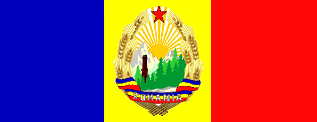
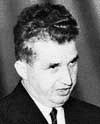 In
1965, Romania mourned the death of its leader and
president, Gheorghe Gheorghiu-Dej. The youngest of the
eight or nine members of the Committee of the Central
Communist Party was Nicolae Ceausescu and he was elected
to succeed the late president Gheorghiu-Dej because it
was reasoned that the country should not have to go
through a national morning every few years. Another
reason that Nicolae Ceausescu was selected to succeed was
because he was by far the least educated (a high school
dropout) and thus it was reasoned that he could easily be
manipulated by the rest of the Central Committee.
In
1965, Romania mourned the death of its leader and
president, Gheorghe Gheorghiu-Dej. The youngest of the
eight or nine members of the Committee of the Central
Communist Party was Nicolae Ceausescu and he was elected
to succeed the late president Gheorghiu-Dej because it
was reasoned that the country should not have to go
through a national morning every few years. Another
reason that Nicolae Ceausescu was selected to succeed was
because he was by far the least educated (a high school
dropout) and thus it was reasoned that he could easily be
manipulated by the rest of the Central Committee.
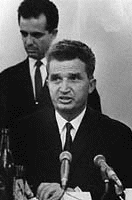 Thus,
the country had to adjust itself and get used to having
and hearing a mumbling idiot as its president giving
political speeches that were so bad and so grammatically
incorrect that this at first produced great bewilderment.
To hear him was one thing, but to see him in countless TV
appearances giving those speeches was another thing. His
off-mark gesticulation with his right hand, his apparent
speech impairment
Thus,
the country had to adjust itself and get used to having
and hearing a mumbling idiot as its president giving
political speeches that were so bad and so grammatically
incorrect that this at first produced great bewilderment.
To hear him was one thing, but to see him in countless TV
appearances giving those speeches was another thing. His
off-mark gesticulation with his right hand, his apparent
speech impairment 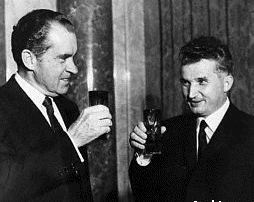 with
struggling and stuttering at almost every word was
irresistibly funny. In fact his speeches produced so much
laughter that they were competing with a popular Romanian
TV series entitled Celebrated Comics of the Screen
(in Romanian Comici Vestiti ai Ecranului)
which featured the short movies of the legendary
"Laurel and Hardy" duo. Soon however, the country was not
laughing any more. Ceausescu's grip on power as the
undisputed ruler had become evident and terribly
frightening because of his uncontrollable power. His
Economic Plan for Romania to pay back all its foreign
debts within ten (10) years was extremely hard on the
country since the plan did not involve policies that
would stimulate the dormant, if not moribund, economy but
instead involved programs of great austerity for the
Romanian nation. Since the absolute bare necessities of
life became scarcer and scarcer, bribery and corruption
began to flourish like never before. In his demented way,
President Ceausescu to "fuel" the economy passed, among
many insane laws, the law that every woman in Romania
must have four (4) children because, as he reasoned,
there were too many retired people in Romania and thus to
offset this undesirable situation, the birth rate in
Romania needed to increase
dramatically.
with
struggling and stuttering at almost every word was
irresistibly funny. In fact his speeches produced so much
laughter that they were competing with a popular Romanian
TV series entitled Celebrated Comics of the Screen
(in Romanian Comici Vestiti ai Ecranului)
which featured the short movies of the legendary
"Laurel and Hardy" duo. Soon however, the country was not
laughing any more. Ceausescu's grip on power as the
undisputed ruler had become evident and terribly
frightening because of his uncontrollable power. His
Economic Plan for Romania to pay back all its foreign
debts within ten (10) years was extremely hard on the
country since the plan did not involve policies that
would stimulate the dormant, if not moribund, economy but
instead involved programs of great austerity for the
Romanian nation. Since the absolute bare necessities of
life became scarcer and scarcer, bribery and corruption
began to flourish like never before. In his demented way,
President Ceausescu to "fuel" the economy passed, among
many insane laws, the law that every woman in Romania
must have four (4) children because, as he reasoned,
there were too many retired people in Romania and thus to
offset this undesirable situation, the birth rate in
Romania needed to increase
dramatically.
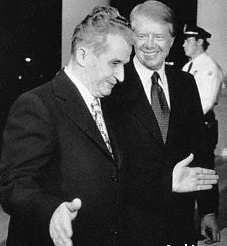 Parallel
to these ridiculous economic policies, brutal
nationalistic policies targeting everything that was not
"pure" Romanian were being implemented. Ethnic cleansing
was one of Ceausescu's most horrendous legacies,
destroying mercilessly entire ethnic villages through
methods not too different from those found in the Hitler
era.
Parallel
to these ridiculous economic policies, brutal
nationalistic policies targeting everything that was not
"pure" Romanian were being implemented. Ethnic cleansing
was one of Ceausescu's most horrendous legacies,
destroying mercilessly entire ethnic villages through
methods not too different from those found in the Hitler
era. 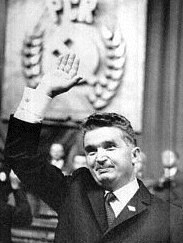 Outside
the country, in foreign affairs, this Romanian
nationalistic offensive was most visibly seen in
Romania's sought after independence from the "influence"
of the Soviet Union. This defiant attitude against the
Soviet Union was, of course, extremely pleasing to the
United States and to rest of the West, and Romania,
politically, was indeed rewarded for its independence.
Since Yugoslavia from 1948, under Marshal Tito, pursued
national Communism with independence from the Soviet
Union, Yugoslavia was never accepted into the Eastern
Block as a "true" Communist country. However, in his
pursuit for political independence, President Ceausescu
developed close ties with Yugoslavia at the expense of
infuriating the Soviet Union even more.
Outside
the country, in foreign affairs, this Romanian
nationalistic offensive was most visibly seen in
Romania's sought after independence from the "influence"
of the Soviet Union. This defiant attitude against the
Soviet Union was, of course, extremely pleasing to the
United States and to rest of the West, and Romania,
politically, was indeed rewarded for its independence.
Since Yugoslavia from 1948, under Marshal Tito, pursued
national Communism with independence from the Soviet
Union, Yugoslavia was never accepted into the Eastern
Block as a "true" Communist country. However, in his
pursuit for political independence, President Ceausescu
developed close ties with Yugoslavia at the expense of
infuriating the Soviet Union even more.
Notwithstanding the
close ties that Romania established with Yugoslavia, one
colossal difference existed between the two neighboring
countries: citizens from Yugoslavia could travel anywhere
in the world with no restrictions; citizens from Romania,
however, were prohibited to travel anywhere outside the
country and when traveling within the country they were
required to notify, in advance, the Romanian police of
their whereabouts. Now, for the purpose of this story,
this is sufficient for the political background of
Romania, so let us move on to Part-2 describing some of
my background. So, if you are ready, press on the
appropriate Continue button below.